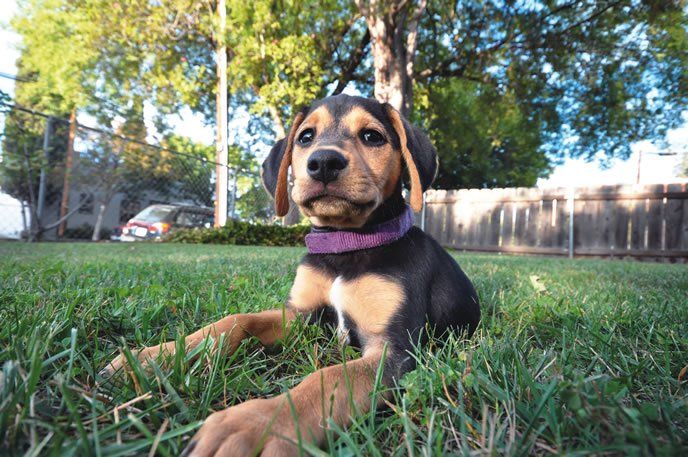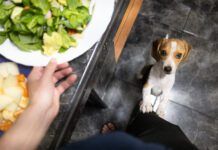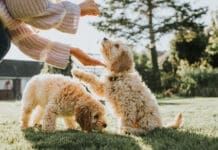In 2008, the American Veterinary Society for Animal Behavior (AVSAB) released a statement affirming that puppy socialization is a critically important tool in the development of a behaviorally normal dog. The organization also confirmed that the risk of a puppy contracting a serious or fatal disease during proper socialization efforts is far less than the risk of a dog later being given up or euthanized due to behavior problems that developed as a result of a lack of socialization. This is an absolutely critical accomplishment for your dog.
One might think that when AVSAB makes a position statement on a canine behavior topic, the case would be closed. Apparently not.
It recently came to my attention that an internationally known speaker and dog trainer is asserting that puppies don’t have a prime socialization period, that they should remain with their litters until they are 10-12 weeks old, and that puppy training classes are bad for puppies and should be avoided. When I read this, I was floored.
In my behavior practice, I still come across the occasional client whose veterinarian exhorted them not to take their pup anywhere out in public until she is fully immunized against contagious diseases, somewhere between the ages of four to six months. It happens often enough that I’m not floored by this, just disappointed. Not surprisingly, I often see those clients’ dogs later, in consultations for fear-related behaviors (often aggression) stemming from a lack of adequate socialization during puppyhood.
What is Dog Socialization?
Socialization involves introducing a puppy to a variety of stimuli (sights, sounds, smells, experiences) and making sure the pup is having a good time while doing so.
Well-socialized puppies become optimists, believing that the world is a happy place and that new things they encounter are probably safe and good unless proven otherwise. They tend to be resilient, able to bounce back quickly in adulthood even if/when a traumatic event occurs.
An unsocialized or undersocialized puppy becomes a pessimist. Everything new is scary and suspect unless you can convince her otherwise—and it’s not easy to do that—hence the generally fearful nature of an undersocialized dog. Traumatic events only confirm her strongly held belief that the world is scary and dangerous.
Canine behavior scientists have determined that the “socialization window”—the critically important time for a pup to receive a good education about the world around her—is even smaller than once thought. Previously, experts thought the period extended to the puppies’ age of 16 or even 20 weeks; today, most agree that the prime socialization window extends only from three weeks to about 13 weeks.
Note that this very important socialization period is more than half over by the time most pups go to their forever homes around the age of eight weeks. Let me repeat that: More than half over!
To help ensure that the products of their breeding become the type of emotionally healthy dogs that they intended to produce, breeders must do their share. If a puppy is already fearful at the age of eight weeks, super-socialization for the month that remains will help, but may not ever completely make up for the missing time. Puppy buyers can easily lose their hearts to the shy puppy who hides under the chair, telling themselves that the little one just needs love to help overcome her fears. This is not usually the case. If the puppy has a genetic predisposition for a confident personality, some of the damage can possibly be repaired, but it takes hard work in addition to love. Still, she will never be the dog she could have been with better socialization during the first five weeks of her prime socializing window.
If she is genetically predisposed to be timid, early socialization is even more critically important. Absent that, dog and human are probably in for 10-15 years of behavior challenges. Since much of the time we really have no knowledge of a pup’s genetic predisposition for a confident or timid personality, behavior experts recommend super-socializing every pup!
Wherever your puppy hails from (breeder, shelter, rescue, friend), ask detailed questions about the socialization she’s had so far. How many different places has she been? How many different kinds of people has she met? What kinds of activities has she done? How did she react to all those things? Your pup should have already at least happily met the “ding!” of the microwave oven, sounds of the washer and dryer, ringing telephone, radio, television, grooming brush and nail clippers, and dozens of different/varied humans.
If you’re meeting her in a whelping box or puppy pen, ask if you can take her outside, away from her littermates. Sometimes a pup will act normal in her familiar environment surrounded by family members whose presence gives her confidence, but become very fearful in a new place. (Note that a good breeder will have already worked with her away from her mom and littermates so her rehoming separation is less of a shock to her.) If you elect to purchase or adopt that timid puppy anyway, know that you are setting yourself up for lots of behavior work.
How to Socialize Your Dog
Remember that socialization is giving your pup good experiences with new things, not just exposing her to new things. To the extent possible, control the environment. Introduce her to children you know, ones who can be counted on to behave appropriately around dogs; don’t just let her be mobbed by the entire Little League team.
Socialize her with other dogs by enrolling in a well-run puppy class that allows puppy playtime as part of the curriculum. Don’t take her to the dog park; if you want her to meet an adult dog, select a dog you know well, one who will be appropriate with her, and introduce them using an appropriate procedure. (See “Great Introductions,” WDJ January 2008). Walk her on suburban sidewalks before exposing her to big city streets.
Pair your pup’s exposure to new things with generous delivery of small (pea-sized) bits of very high-value treats, so she thinks new stuff means good stuff. If she’s comfortable meeting new humans, give them several treats to give her, so “new humans” become reliable predictors of “yummy treats!” (Be sure to strongly caution your humans not to grab for or otherwise frighten her.) If she’s a bit worried about new humans, you feed the high-value treats in the presence of strangers until she is quite happy about their presence, then they can feed her the treats.
You can also use favored activities – play with a toy, scratches behind the ear, searching on the ground for “Find it” treats – to give her a positive association with new people, places, and new things. Your socialization goal is to always make sure she is always having a good time as you introduce her to the world during this important period of her life.
If she won’t eat super-scrumptious treats or won’t play with her favorite toy, she is telling you she is very uncomfortable with her surroundings. You need to act immediately by moving her away to a safe distance – far enough away that she’s happy to take treats and play again.
Next, make a mental note (and write it down later) of what it was that may have been of concern to her, and plan to do more work around those stimuli – a certain type of human (male, child, large, small, pushing a cart, wearing a uniform, etc.), a thing (garbage truck, elevator, manhole cover, another dog, recycle bin, etc.), a sound (thunder, beeping of a truck backing up, applause, crowd cheering) or a surface (gravel, concrete, sand, hardwood floor).
In each case, you will use counter-conditioning and desensitization to work on increasing her comfort level, by presenting the stimulus or stimuli at an intensity she is comfortable with, and feeding treats or playing with toys there until she is happy. Increasing the distance between the dog and the stimuli will usually decrease their intensity; when you are far enough away you can use treats and/or toys to get her happy, then gradually move closer – by inches at a time – and get her happy at each new location before moving closer again.
Experiences most pups should have at an early age include:
Places: Car, vet, groomer, beach, park, woods, trails, school, shops, friends’ houses, crate, public transport, cafe, training facility, stairs, hardwood floors, carpet, gravel, grass, cement, other unusual surfaces (walking on a tarp, a teeter-totter, stone wall, fallen log).
People: Friends; neighbors; family; children; elderly people; men with deep voices; men with beards; people of all different skin colors; people in hats and sunglasses; people carrying boxes and bags; people wearing various outfits (saris, turbans, tool belts, uniforms, backpacks, babies in a carrier, etc.); people with wheelchairs, strollers, or walkers; people on bicycles, skates, and skateboards; people running, crawling, skipping, and playing sports; people who ignore dogs, and people who are affectionate toward dogs.
Animals: Other puppies, other dogs, individual dogs, groups of dogs, working dogs, playing dogs, cats, fish in a tank, Guinea pigs, rabbits, parrots, poultry, horses, livestock.
Things: Brooms, mops, vacuums, dishwashers, fans, weed-whackers, power tools, ladders, children’s toys, manhole covers, trucks, buses, snow blowers.
You get the idea . . . the possibilities are endless!
Fear Periods in Puppies
Behavior professionals also talk about “fear periods” in young dogs; this is different from the prime socialization window, though they may overlap. These are times when puppies or adolescent dogs are more likely to react fearfully to new stimuli, or even to stimuli they’ve been exposed to in the past and were seemingly comfortable with.
Although specific time periods have been identified by various experts as when fear periods are more likely to occur, current thinking is that those periods are not as rigidly fixed as once thought. It has been suggested that one fear period is around 8-12 weeks – the time when most puppies are going to their new homes, and the time when super-socialization should be occurring. It’s probably a good idea to not ship pups by air or truck transport during this period (if ever). If your pup is coming to you from across the country, I strongly advise driving her home rather than shipping her, or arranging for another trusted person to drive her. Far too many scary things can happen during shipping.
Later on, a dog may seem more susceptible to a strong fear response during periods that occur any time between the age of 6 to 14 months, which makes it less a true “fear period” and more about just life as a dog. Real or not, it’s less important to worry about whether the pup is in a fear period than it is to respond appropriately any time your dog or puppy shows fear.
Here’s how to deal with fear behaviors, both during your socialization efforts and beyond:
■ Remain Calm. Dogs excel at reading our emotions and body language. If you react badly when your pup is fearful, you can compound her fear response. Stay calm and relaxed, and remember to breathe. Act as if it’s no big deal, and help her out of the situation.
■ Counter-Condition. The moment your dog sees the threatening stimulus, feed high-value treats. Pause, let her look again, then feed again. Do not ask her to “sit” or watch you, just feed.
You aren’t giving treats for a particular behavior; you are trying to create a positive association between the scary thing and the treats. In fact, asking for a specific behavior can be counterproductive.
You can also use counter-conditioning for scary sounds. Associate the sound with your pup’s high value treat, and she will come to love the sound. Important: If your pup won’t eat the treats she is probably “over threshold” – the scary thing is too close, or the noise is too loud. Increase distance or find a way to turn down the volume.
■ Move Away. It is perfectly okay, in fact often advisable, to increase distance between your pup and the scary thing, until enough counter-conditioning is done to change the association from “Ooooh, scary!” to “Yay, treats!” If you find yourself having to move away frequently, it’s time to up your management game so your pup doesn’t keep finding herself too close to scary things.
■ Socialize. As discussed above, socialization is your best immunization against fear. While even a well-socialized optimistic pup may go through fear periods, she will be far more resilient and recover more quickly if she has a solid foundation of socialization. While her primary socialization window may close at 13-14 weeks, you will want to continue to give her positive social experiences throughout her life.
■ Don’t Punish. It should go without saying, but we’ll say it anyway. Don’t ever punish your pup for fear-related behaviors (or other behaviors, for that matter). She’s already convinced bad things happen when that scary thing is near, and if you punish her you will confirm her suspicions and exacerbate her fear. Instead, let her know she can rely on you for support when she is scared.
Well-socialized dogs are made, not born. Even given the genetic component, your pup’s future behavioral well-being is in your hands. Take the time to super-socialize now, and your optimistic dog will confidently romp through life with you. Cut corners with your socialization program, and you and your canine pessimist are likely to pay the price in fear-related behaviors, even aggression, a life full of stress, and major restrictions on what activities she can share and enjoy with you. Seems like a pretty easy choice, yes?
Pat Miller, CBCC-KA, CPDT-KA, is WDJ’s Training Editor. She lives in Fairplay, Maryland, site of her Peaceable Paws training center, where she offers dog-training classes and courses for trainers. Pat is also the author of many books on positive training. Her two most recent books are Do Over Dogs: Give Your Dog a Second Chance at a First-Class Life, and How to Foster Dogs; From Homeless to Homeward Bound.







Nice article keep up the nice work.